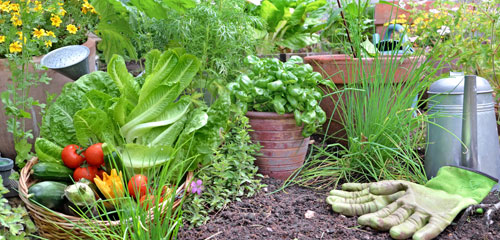Pretty well, if you take our advice on how to care for it this month
August is traditionally the month of hosepipe bans and heatwaves, and while it’s grand to get the sun loungers out and drink Pimm’s all day, if you want your garden to look decent not only now, but through autumn, you’ll have to put the hours in.
There are a lot of jobs that can’t wait, so we’ve picked out the most important ones to ensure that your garden looks better than your neighbours’ in no time.
Deadheading
If you have plants growing in hanging baskets or containers, they will need deadheading as soon as the blooms begin to fade. Most plants allow for removal of faded blooms with nothing more than your finger and thumb, but there are some flowers which require a little more care than a quick pluck.
When it comes to roses, break the stalk just below the head of the flower and snap off. For geraniums you’ll need to pinch the faded stalk near the base and pull downwards. The faded bloom should come off easily.
Cutting back
Rhododendrons, azaleas and camelias also need cutting back this month. Use your finger and thumb to snap off the dead bloom at the point that it joins the stem. Watch out for new buds that might be growing just below the faded flower; these will be next year’s magic so you’ll want to keep them intact. You can use secateurs to cut just below the dead bloom if you prefer.
Dahlias, calendulas and lilac have fairly tough stems, so bring out your secateurs for these guys, too. Don’t wrestle with a tough stem; you’ll only damage the plant. If you have lupins, delphiniums and geraniums that have kept going over the seasons, they may produce secondary blooms. Enjoy those if they do, then cut them close to ground level once they’ve finished flowering.
Dig deep and deal with the bulbs
If you’ve enjoyed spring bulbs such as daffodils and want them to pop up next March, they’ll also need some attention. Remove the dead flowers and the seed capsule, but don’t go mad – ensure you leave the stalk well alone to allow for photosynthesis (remember that from biology lessons?) to do its work.
You can also buy daffodil – and other – bulbs if you’re the kind of person who thinks that far ahead, and plant them. Bingo!
Loving your lawn
As far as mowing the lawn goes, you’ll want to do it lightly and often, rather than wading through it when it’s knee-deep and hacking it to bits every fortnight. You can leave the clippings on the lawn if you wish, as they help retain moisture, especially if it’s been raining.
Grass can manage through a drought, so don’t panic if it looks dry. If your lawn is new, however, then knock yourself out and water it lightly every couple of days. If you don’t have a water butt, you can use ‘grey water’ – that’s the leftovers from a bath or rinse cycle washing machine water. Use it within 24 hours as leaving it any longer than that might mean it's full of bacteria.
Don’t make a habit of using grey water, though – it’s really your ‘oh no, not another hosepipe ban’ go-to for a week or two. And compost the clippings if you’ve got a compost bin.
Gardening for the kitchen – and our garden friends
If you’re lucky enough to have a vegetable patch or allotment, you can crack on with planting some veg. Leafy greens such as lettuce, spinach, collard, and kale can all go in this month. Charlotte potatoes will also do well if sown now. Carrots, radishes, and beetroot too – all can be started from seeds. Clever little seeds!
On a side note, don’t forget to keep bird bowls topped up with water, and get ready for hedgehogs, too. Never put out bread and milk for them; give them little kitten biscuits instead. If you don’t attract a hedgehog, the slugs will absolutely LOVE you. If you have a visiting hedgehog, the bonus for him will be his cat food coming with a side order of fresh slug!
Give the wood some love
Yes, it’s hot out there, but you’ll thank yourself come winter/spring if you can spruce up your shed and your fence. When the howling winds and battering rains hit, you’ll be glad you did it. You can go traditional with clear varnish or Ronseal, or brighten things up with a coloured exterior wood paint.
Gone are the days of varying shades of rust and brown for your fence. You can find some beautiful shades – pinks, blues, yellows and greens – while dark purples, sage green or even black can look really striking, especially if there are vibrant plants and flowers in front of it. I’d go for Ronseal’s Outdoor Garden Paint in Summer Sky and Pink Jasmine if I had my way (and if I had a fence and shed) – bright pops of pink and turquoise will liven up your space in no time. Their garden paint is guaranteed to protect wood for up to five years.
Once you’ve painted your wood, make sure you treat it with preservative or varnish, and do this every other year if you can. It’s boring, but it’s worth it.
To prepare for painting, first brush or wipe the panels to remove anything sticking to it. That could be cobwebs, flies, moss or grass clippings. Remember to put masking tape around the edges of windows, too because there is nothing worse than forgetting to do that and ending up with a nice streak of paint across your glass that you’ll have to spend a good (hot) hour scraping off. It’s all in the preparation, so don’t skimp!



